DL205 CPUs Overview
Please select one of the links below to view further detail on the various DL205 CPUs:
D2-260 CPU
Our most powerful DL205 CPU
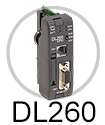 Our
new D2-260 CPU provides all the capabilities of the other DL205 CPUs (as
well as our D4-450 CPU), plus several additional features rarely found
in a PLC of this size. With such an incredible array of features, you
may be able to replace PLCs costing hundreds (or thousands) more. Release
4.0 or higher of DirectSOFT32™ is required to program the
D2-260. If you’re using a handheld programmer, version 2.10 of the handheld
programmer firmware will is required. Here are a few key features about
the D2-260 CPU:
Our
new D2-260 CPU provides all the capabilities of the other DL205 CPUs (as
well as our D4-450 CPU), plus several additional features rarely found
in a PLC of this size. With such an incredible array of features, you
may be able to replace PLCs costing hundreds (or thousands) more. Release
4.0 or higher of DirectSOFT32™ is required to program the
D2-260. If you’re using a handheld programmer, version 2.10 of the handheld
programmer firmware will is required. Here are a few key features about
the D2-260 CPU:
- Local expansion I/O
The D2-260 supports local expansion up to five total bases (one CPU base and four expansion bases). Expansion bases are commonly used when there are not enough slots available in the CPU base, when the base power budget will be exceeded or when placing an I/O base at a location away from the CPU base, but within the expansion cable limits, if desired. All local and expansion I/O points are updated on every CPU scan. Each local expansion base requires the D2-CM module in the CPU slot. The local CPU base requires the D2-EM Expansion Module, as well as each expansion base.
- Powerful built-in CPU communications
The D2-260 offers two communications ports that provide a vast array of communication possibilities. The top RJ-12 RS-232C port can be used for programming, connection to an EZText/EZTouch or DV-1000 operator interface panel, or as a K-sequence or DirectNET slave. The 15-pin bottom port (port 2) supports RS232C or RS422/RS485. This port offers several different protocol options such as:- K-sequence
- DirectNET Master/Slave
- MODBUS RTU Master/Slave
- ASCII In/Out Communications
- 16 PID loops with auto-tuning
The D2-260 CPU can process up to 16 PID loops directly in the CPU. You can select from various control modes including automatic, manual, and cascade control. There are also a wide variety of alarms including Process Variable, Rate of Change, and Deviation. The loop operation parameters (Process Variable, Setpoint, Setpoint Limits, etc.) are stored in V-memory, which allows easy access from operator interfaces or HMIs. Setup is accomplished with easy-to-use setup menus and monitoring views in DirectSOFT32 programming. The auto-tuning feature is easy to use and can reduce setup and maintenance time. Basically, the CPU uses the autotuning feature to automatically determine near optimum loop settings.
- Full array of instructions
The right instruction can greatly simplify your programming task and can save hours of programming time. The D2-260 supports over 225 powerful instructions, such as:- Four types of drum sequencers
- Leading / trailing edge triggered oneshots
- Bit of word manipulation
- Floating point conversions
- Trigonometric functions
- Table instructions
- ASCII IN/OUT instructions
- New MODBUS RTU instructions
The D2-260 CPU supports new easy-to-use MODBUS Read/Write instructions that expand our existing MODBUS network instruction capabilities. The MRX or MWX instructions allow you to enter native Modbus addressing in your ladder program with no need to perform octal to decimal conversion. We added Function codes 05, 06 and the ability to read Slave Exception Codes. These flexible instructions allow the user to select the following parameters within one instruction window:- 584/984 or 484 MODBUS data type
- Slave node (0-247)
- Function code
- MODBUS starting master / slave memory address
- Number of bits
- Exception code starting address
D2-250-1 CPU
D2-250-1 replaces the D2-250
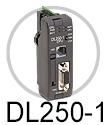 Our
new D2-250-1 CPU replaces the D2-250 CPU. The D2-250-1 offers all the
features and functionality of the D2-250 with the addition of local I/O
expansion capability. The D2-250-1 offers an incredible array of features
for a CPU that costs so little. Release 2.1 or higher of DirectSOFT™ is
required to program the D2-250-1. Release 4.0 is required if you intend
to use local expansion I/O. If you’re using a handheld programmer, version
2.10 of the handheld programmer firmware is required. Following are a
few key features of the D2-250-1 CPU:
Our
new D2-250-1 CPU replaces the D2-250 CPU. The D2-250-1 offers all the
features and functionality of the D2-250 with the addition of local I/O
expansion capability. The D2-250-1 offers an incredible array of features
for a CPU that costs so little. Release 2.1 or higher of DirectSOFT™ is
required to program the D2-250-1. Release 4.0 is required if you intend
to use local expansion I/O. If you’re using a handheld programmer, version
2.10 of the handheld programmer firmware is required. Following are a
few key features of the D2-250-1 CPU:
- Local expansion I/O
The D2-250-1 supports local expansion up to three total bases (one CPU base and two expansion bases). Expansion bases are commonly used when there are not enough slots available in the CPU base, when the base power budget will be exceeded or when placing an I/O base at a location away from the CPU base, but within the expansion cable limits. All local and expansion I/O points are updated on every CPU scan. Each local expansion base requires the D2-CM module in the CPU slot. The local CPU base requires the D2-EM Expansion Module, as well as each expansion base.
- Powerful built-in CPU communications
The D2-250-1 offers two communication ports that provide a vast array of communication possibilities. The top RS232C port is for programming, connection to an EZText/EZTouch operator interface panel or DV-1000, or to serve as a DirectNET slave. The 15-pin bottom port (port 2) supports RS232C or RS422. This port offers several different protocol options such as K-sequence, DirectNET master/slave, or MODBUS RTU master/slave. Port 2 can also serve as a remote I/O master. The D2-250 supports the Ethernet Communication Module and Data Communication Module for additional communications ports.
- Four PID loops with auto-tuning
The D2-250-1 CPU can process up to 4 PID loops directly in the CPU. You can select from various control modes including automatic, manual, and cascade control. There are a wide variety of alarms including Process Variable, Rate of Change, and Deviation. The loop operation parameters (Process Variable, Setpoint, Setpoint Limits, etc.) are stored in V-memory, which allows easy access from operator interfaces or HMIs. Setup is accomplished with easy-to-use setup menus and monitoring views in DirectSOFT32 programming. The auto tuning feature is easy to use and can reduce setup and maintenance time. Basically, the CPU uses the autotuning feature to automatically determine near optimum loop settings.
- Full array of instructions
The D2-250-1 supports over 160 powerful instructions, such as:- Four types of drum sequencers
- Leading and trailing edge triggered oneshots
- Bit of word manipulation
- Floating point conversions
- 4 PID loops
- On-board memory
The D2-250-1 has 7.6K words of flash memory on board for your program plus 7.1K words of V-memory (data registers). With flash memory, you don’t have to worry about losing the program due to a bad battery. If you have critical data stored in the capacitor-backed V-memory, simply purchase the optional lithium battery (D2-BAT-1) to permanently maintain these parameters.
- Built-in remote I/O connection
In addition to providing outstanding communications capabilities, the bottom port on the D2-250-1 can also be a master for remote I/O networks. If you need extra I/O at a remote distance from the CPU, you can use this port to add up to seven of our remote slave stations.
D2-240 CPU
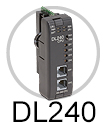 The
D2-240 provides a subset of the D2-250-1's capabilities. If you need a
good CPU with multiple communications ports and complex math or PID isn't
required, then the D2-240 is the CPU for you!
The
D2-240 provides a subset of the D2-250-1's capabilities. If you need a
good CPU with multiple communications ports and complex math or PID isn't
required, then the D2-240 is the CPU for you!
- Built-in memory
There is 2.5K of EEPROM program memory in the D2-240. No additional memory is required. If you have critical data stored in the capacitor-backed V-memory, simply purchase the optional lithium battery (D2-BAT) to permanently maintain these parameters as well.
- Powerful instructions
The D2-240 instructions cover most of the capability of our more powerful D2-250-1 and allow you to cover a wide variety of applications. Instructions include boolean logic, data manipulation, integer math, interrupts, subroutines, FOR/NEXT loops, and more.
- Two built-in RS232C communications
ports
The D2-240 offers two communications ports. The top port can be used for a direct connection to a personal computer for programming, to our handheld programmer, EZTouch/EZText panels, or to the DV-1000. The bottom port is a slave-only port and supports our DirectNET or K-sequence protocol at speeds up to 19.2K baud. If you're using an operator interface or plan on connecting the system to a network later on, then you can choose the D2-240. The D2-240 also supports the D2-DCM Data Communications Module and the H2-ECOM Ethernet Communications Module.
D2-230 CPU
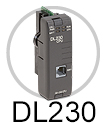 The
D2-230 is our most economical CPU for the DL205 product family. If you
are looking at the DL205 primarily because of the size or for other reasons
that don't require lots of CPU horsepower, then give the D2-230 a try.
The
D2-230 is our most economical CPU for the DL205 product family. If you
are looking at the DL205 primarily because of the size or for other reasons
that don't require lots of CPU horsepower, then give the D2-230 a try.
- Built-in EEPROM memory
There is 2.0K of EEPROM program memory in the D2-230. No additional memory is required. If you have critical data stored in the capacitor-backed V-memory, simply purchase the optional lithium battery (D2-BAT) to permanently maintain these parameters as well.
- One built-in communications port
The D2-230 has only one communication port. If you are considering any network connections in the future, you will need the D2-240, D2-250-1, or D2-260 CPU. The extra port on those CPUs may be worth the cost, especially during machine startup or troubleshooting sessions. The D2-230 does not support the Ethernet or Data Communications modules.
- Basic instruction set
The D2-230 provides a subset of the D2-240's well-rounded instructions. The D2-230's instructions cover basic boolean and simple integer math.
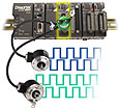 H2-CTRIO
counter module
H2-CTRIO
counter module 
 Specialty
modules for those special occasions
Specialty
modules for those special occasions